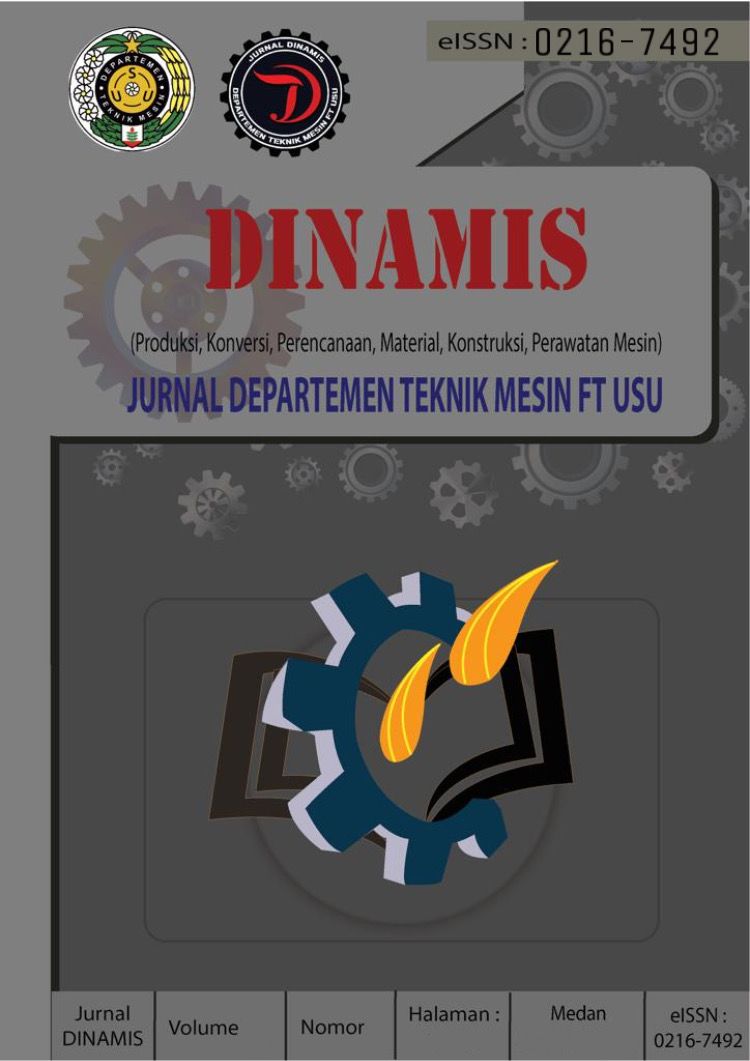THE DOUBLE WISHBONE SUSPENSION DESIGN OF THE GAJAH OLING ELECTRIC VEHICLE
DOI:
https://doi.org/10.32734/dinamis.v11i2.14228Keywords:
Electric car, double whisbone suspension, Suspension, Motion simulationAbstract
The ongoing development of electric vehicles is aimed at swapping conventional fossil fuel-powered automobiles, namely those reliant on petrol and diesel. In order to achieve optimal use in practical scenarios, electric vehicles must possess the capability to navigate diverse terrain elements. The utilization of suspension systems serves the objective of reducing the magnitude of the load exerted on the tires, hence facilitating enhanced driver control over the electric vehicle. The spring performance of the suspension system in an electric car design is evaluated for different weight configurations. Specifically, when the car weight 120.4 Kg, the suspension exhibits a spring constant of 59.0N/m. Similarly, when the weight is 115.4 Kg, the suspension system demonstrates a spring constant of 62.8N/m. Finally, in the front suspension configuration with a weight of 129.4 Kg, the spring constant is measured to be 57.7 N/m. The constant data have been aggregated to determine that the maximum load capacity of the suspension system under shock conditions is 365.8 kg. Based on the findings of the design results, it was seen that the highest damping constant was recorded in the case of a load weighing 120.4 Kg, specifically in the low mode with a value of 285.41 Ns/m, and in the mid mode with a value of 196.6 Ns/m.
Downloads
References
Z.-M. Chen and G. Q. Chen, “An overview of energy consumption of the globalized world economy,†Energy Policy, vol. 39, no. 10, pp. 5920–5928, 2011.
H. Achour and A. G. Olabi, “Driving cycle developments and their impacts on energy consumption of transportation,†J. Clean. Prod., vol. 112, pp. 1778–1788, 2016.
J. I. A. Shunping, P. Hongqin, L. I. U. Shuang, and X. Zhang, “Review of transportation and energy consumption related research,†J. Transp. Syst. Eng. Inf. Technol., vol. 9, no. 3, pp. 6–16, 2009.
J. Cherry and T. Merichko, “Battery durability in electrified vehicle applications: a review of degradation mechanisms and durability testing,†Prep. Environ. Prot. Agency Ann Arbor, MI, USA, 2015.
Z. S. Gelmanova et al., “Electric cars. Advantages and disadvantages,†in Journal of Physics: Conference Series, 2018, vol. 1015, no. 5, p. 52029.
E. Helmers and P. Marx, “Electric cars: technical characteristics and environmental impacts,†Environ. Sci. Eur., vol. 24, no. 1, pp. 1–15, 2012.
M. S. Ramkumar et al., “Review on Li-Ion Battery with Battery Management System in Electrical Vehicle,†Adv. Mater. Sci. Eng., vol. 2022, 2022.
X. Wang et al., “A critical review on thermal management technologies for motors in electric cars,†Appl. Therm. Eng., vol. 201, p. 117758, 2022.
Z. Bitar and S. Al Jabi, “Studying the performances of induction motor used in electric car,†Energy Procedia, vol. 50, pp. 342–351, 2014.
L. S. Martins, L. F. Guimarães, A. B. B. Junior, J. A. S. Tenório, and D. C. R. Espinosa, “Electric car battery: An overview on global demand, recycling and future approaches towards sustainability,†J. Environ. Manage., vol. 295, p. 113091, 2021.
R. Sardagi and K. S. Panditrao, “Design analysis of double wishbone suspension,†Int. J. Res. Eng. Tech, vol. 3, no. 3, pp. 1163–2319, 2014.
M. Z. A. Manaf, M. F. A. Latif, M. S. A. Razak, M. Z. B. Hassan, and M. I. F. Rosley, “Suspension kinematic analysis of UTeM’s FV Malaysia electric vehicle racing car,†Int. Rev. Mech. Eng., vol. 10, no. 4, pp. 294–300, 2016.
A. Bhoraskar, A. Fartyal, and P. Sakthivel, “Analysis of the Double Wishbone front suspension system,†in 2017 International Conference on Nascent Technologies in Engineering (ICNTE), 2017, pp. 1–5.
P. Upadhyay, M. Deep, A. Dwivedi, A. Agarwal, P. Bansal, and P. Sharma, “Design and analysis of double wishbone suspension system,†in IOP Conference Series: Materials Science and Engineering, 2020, vol. 748, no. 1, p. 12020.
F. O. Mahroogi and S. Narayan, “Design and analysis of Double Wishbone suspension systems for automotive applications,†Int. J. Mech. Prod. Eng. Res. Dev., vol. 9, no. 4, pp. 1433–1442, 2019.
M. L. Junior, J. Greaves, C. Smout, and M. Gimeno-Fabra, “Kinematic design and finite element analysis of a suspension system for a four wheel drive electric formula student vehicle,†MM4MPR Individ. Res. Pap., vol. 18, pp. 1–16, 2017.
N. Aisyiyah, “Pemodelan Sistem Suspensi Kendaraan Dengan Menggunakan Software Solidwork,†Inst. Teknol. Sepuluh Novemb., 2016.
D. C. Barton, J. D. Fieldhouse, D. C. Barton, and J. D. Fieldhouse, “Suspension systems and components,†Automot. Chass. Eng., pp. 111–214, 2018.
A. E. Nabawy, A. A. Abdelrahman, W. S. Abdalla, A. M. Abdelhaleem, and S. S. Alieldin, “Analysis of the dynamic behavior of the double wishbone suspension system,†Int. J. Appl. Mech., vol. 11, no. 05, p. 1950044, 2019.
D. Güler, Dynamic analysis of double wishbone suspension. Izmir Institute of Technology (Turkey), 2006.
Additional Files
Published
How to Cite
Issue
Section
License
Copyright (c) 2023 DINAMIS

This work is licensed under a Creative Commons Attribution-ShareAlike 4.0 International License.






